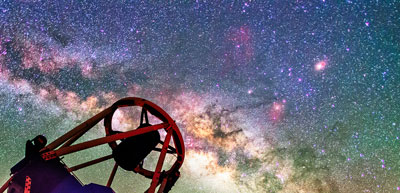
The Liverpool Telescope. ©2017 Daniel López/IAC
Twenty years ago, on 22 April 2004, a key milestone in the commissioning of the Liverpool Telescope was passed when control of the night was handed over to the LT's robotic scheduler for the first time.
The Liverpool Telescope was originally conceived in the 1990s as a joint venture between Liverpool John Moores University and the Royal Greenwich Observatory. The telescope was constructed on Merseyside in the UK by Telescope Technologies Ltd., a spin-off company of the university. First light for the telescope was achieved in the summer of 2003, but as any user of the telescope will know the key capability of the telescope is its robotic control system, enabling rapid and flexible observations of the time variable sky. The beginning of robotic observing then is really the birth of science operations at the telescope. Present at the observatory in 2004 were LT staff Iain Steele and Steve Fraser, and they described the first robotic run as "overall very pleasing".
In the 20 years since, LT data has contributed to over 1060 peer reviewed publications, and via The Schools Observatory over 200,000 telescope observations have been obtained for thousands of schools across the UK, Ireland and Spain. Despite the age of the facility the future of the Liverpool Telescope is bright: it is one of the world's leading facilities for transient classification, and continues to deliver important, time critical observations across a range of observing programmes. 2024 is a big year for the telescope: we have already seen the successful commissioning of LIRIC, the LT's newest instrument, and major engineering works are planned through the summer which will see the replacement of the encoder systems on all three axes, replacement of the hydraulic rams which drive the opening and closing of the enclosure, and realuminising of the telescope mirrors. These works will ensure the reliability and productivity of the telescope for years to come.


